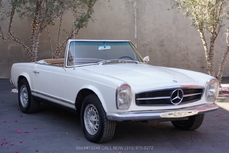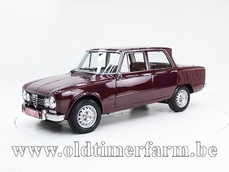Mercedes-Benz 250SL w113 SL Pagode + Hardtop '66 1966
General description :
The original 300SL established the SL name, but it was the family of SLs, starting with the 1963 230SL, that made it big business for Mercedes. Effectively replacing the 190SL and 300SL, the '63 230SL was about the same length as the 190SL, but about the same width as the 300SL and, like the 300SL, powered by a fuel-injected six-cylinder engine. It was plusher than the 190SL, but less expensive than the lavishly detailed 300SL, and so civilized that it was the first SL to be offered with air conditioning and an automatic transmission. With its square cut lines, the 230SL set the styling idiom for subsequent Mercedes products throughout the '60s. But it was the optional hardtop, which dipped at the center, that was the car's most distinctive feature. It was designed to maximize the height of the side windows to improve visibility and ease getting in and out of the car. The result was a roof that looked like a pagoda, and that became the name that stuck with the car. Like the 190SL, the 230SL's chassis was strictly conventional (for a Mercedes). The suspension consisted of double wishbones up front and the rear still had those somewhat nasty swing arms. The body was mostly made of steel, except for the doors, hood and deck lid, which were aluminum. Mercedes also claimed that this new SL was the first sports car to feature a rigid cockpit protected by front and rear crumple zones (which the company had pioneered on its sedans). It was the first passenger car to have an alternator rather than a generator and the first sports car with an automatic transmission (conveniently overlooking that the first Corvette in 1953 was offered only with a two-speed automatic). ower for the 230SL came from a slightly enlarged version of the 2.2-liter OHC straight six then powering the maker's mid- and full-size sedans. Displacing 2.3 liters and breathing through Bosch mechanical fuel injection, it was rated at a full 170 horsepower. The manual transmission was a conventional four-speed, but the optional automatic used a fluid coupling instead of a torque converter and functioned as a clutchless semiautomatic. The 230SL was a sensation, attracting not just men but — thanks to the automatic transmission, elegant appearance and tasteful appointments — women. It wasn't really a sports car as much as a relentlessly practical (even the trunk was large) two-seater of grace, luxury and competence. And Mercedes didn't tamper with it much over the next eight years. The 250 SL was introduced at the 1967 Geneva Motor Show. Production had already commenced in December 1966 and ended in January 1968. The short one-year production run makes the 250 SL the rarest of the W 113 series cars. The 250 SL retained the stiffer suspension and sportier feel of the early SLs, but provided improved agility with a new engine and rear disc brakes. Like its predecessor, the 250 SL was offered with a 4-speed automatic transmission, and 4-speed or ZF 5-speed manual transmissions. For the first time, an optional limited slip differential was also available. The main change was the use of the 2,496 cc (2.5 L) M129 II engine. The wider power band of the 250 SL resulted in noticeably improved performance compared to the 230 SL. Specifications Bodywork Length : cm (in): 429 (168.7) Width : cm (in): 176 (69.3) Height : cm (in): 131 (51.4) Wheelbase : cm (in) : 240 (94.5) Weight: kg (lb) : 1300 (2869) Mechanics. Displacement : straight 6 2496 cc (152 ci), front-mounted Valve gear : 12 Fuel system : Bosch injection Gearbox : 4-speed manual Drive wheels : rear-wheel drive Left-hand drive Maximum power : 148 bhp at 5500 rpm Maximum torque : 216 Nm at 4200 rpm Maximum speed : 200 km/h (124 mph)
1966 Mercedes-Benz 250SL w113 SL Pagode + Hardtop '66 is listed for sale on ClassicDigest in Aalter by Oldtimerfarm for €82500.
Car Facts
Car type : Car Make : Mercedes-Benz Model : 250SL w113 Model Version : SL Pagode + Hardtop '66 Engine size : 0.0 Model Year : 1966 Location : Aalter Vehicle Registration : Undefined
82500 €
People who viewed this Mercedes-Benz 250SL w113 also viewed similar Mercedes-Benz listed at ClassicDigest
Other cars listed for sale by this dealer
About Mercedes-Benz
In the annals of automotive history, the journey of Mercedes-Benz is a tale that unfolds with the ingenuity of its founding pioneers. In the year 1886, Karl Benz crafted the Benz Patent Motorwagen, a creation that would go down in history as the world's inaugural automobile. Unbeknownst to him, this moment marked the genesis of what would evolve into the most illustrious premium car manufacturer globally. The financial underpinning of this pioneering venture, interestingly, was provided by Karl Benz's wife, Bertha Benz, demonstrating a remarkable partnership that would set the tone for Mercedes-Benz's legacy.A parallel narrative emerged not far away, as Daimler-Motoren-Gesellschaft, founded by Gottlieb Daimler and Wilhelm Maybach, entered the scene. In 1901, they unveiled their automobile under the now-famous moniker "Mercedes," meaning "godsend" in Spanish. This name was bestowed upon the car at the behest of Emil Jellinek's daughter, the distributor for Daimler-Motoren-Gesellschaft. The wheels of innovation were set in motion.
Fast forward to 1926, a pivotal year that witnessed the merger of Daimler with Benz & Cie., culminating in the birth of Daimler-Benz. The amalgamation saw the adoption of "Mercedes-Benz" as the distinguished trademark for their automobiles, fusing the legacies of two visionary entities into one.
Contrary to perceptions of conservatism, the trajectory of Daimler-Benz unfolds as a chronicle of industry firsts. From the introduction of the honeycomb radiator to the float carburetor, and the pioneering implementation of four-wheel brakes in 1924, Daimler-Benz consistently pushed the boundaries of automotive innovation. The diesel-powered Mercedes-Benz 260 D in 1936 marked the inception of diesel engines in passenger cars. The iconic Mercedes-Benz 300SL Gullwing made history as the first car with direct fuel injection, albeit the Gutbrod's tiny 2-stroke engine can claim precedence.
Safety innovations became a hallmark, with Béla Barényi's patented safety cell design in the "Ponton"-models in 1951, featuring front and rear crumple zones. The W116 450SEL 6.9 saw the introduction of the Anti-Lock Brake system (ABS), another pioneering safety feature. From the first production airbags and beyond, the legacy of "firsts" continued to be etched into the fabric of Daimler-Benz.
Over its centennial journey, Mercedes-Benz has not merely produced cars but has sculpted automotive icons. The SSKL, 710 SSK Trossi Roadster, 770K Grosser, 540K Spezial Roadster, 300SL Gullwing, w100 600 Pullman, w111 280SE 3.5 Flachkühler, w113 230SL Pagoda, w109 300 SEL 6.3, and w201 2.3-16 Cosworth stand testament to the brand's commitment to engineering excellence.
The roaring Silver Arrows, or "Silberpfeile," including the W 25, W 125, W154, W165, and W196, created a legacy of dominance on the racetrack. These machines were not merely cars; they were expressions of precision, speed, and an indomitable spirit that left their competitors in the dust.
As Mercedes-Benz marches into the future, it does so not just as an automaker but as a custodian of a legacy, a torchbearer of innovation, and a beacon of automotive excellence. The road ahead is sure to witness the continued fusion of cutting-edge technology, timeless design, and an unwavering commitment to setting new standards in the world of automobiles.
One luminary figure who left an indelible mark was Béla Barényi, often heralded as the "father of passive safety" for his pioneering work in safety engineering. His patented safety cell design, featuring front and rear crumple zones, became a hallmark of Mercedes-Benz's commitment to occupant safety, setting new standards that reverberated throughout the automotive world.
Moving through the chronicles, the collaborative genius of Wilhelm Maybach, alongside Gottlieb Daimler, laid the foundation for Daimler-Motoren-Gesellschaft. Their innovations not only birthed the first Mercedes but established a culture of relentless pursuit of technological excellence that remains integral to Mercedes-Benz's DNA.
In the post-merger era of 1926, Ferdinand Porsche emerged as a prominent figure within Mercedes-Benz. His work on the Mercedes-Benz S-Type, a supercharged race car, garnered acclaim and set the stage for a legacy that extended far beyond the marque. Porsche's impact would later extend to his eponymous company, but his influence at Mercedes-Benz during those formative years was pivotal.
As the 20th century progressed, the legendary Rudolf Uhlenhaut emerged as a key figure. Uhlenhaut, an accomplished engineer and the driving force behind the iconic Silver Arrows, played a crucial role in Mercedes-Benz's dominance in motorsports. His engineering prowess and attention to detail were instrumental in creating some of the most formidable racing cars of the era.
In the latter half of the century, figures like Bruno Sacco, the head of design at Mercedes-Benz from 1975 to 1999, left an indelible imprint on the brand's aesthetic identity. Sacco's design philosophy, characterized by clean lines and timeless elegance, shaped iconic models like the W126 S-Class and the W201 190E, solidifying Mercedes-Benz's reputation for luxury and sophistication.
The narrative would be incomplete without acknowledging the contributions of engineers like Hans Scherenberg, whose leadership in the 1970s ushered in a new era of technological innovation at Mercedes-Benz. Scherenberg's tenure saw the development of groundbreaking technologies, including the Anti-Lock Brake system (ABS) and the introduction of airbags in production cars.

























